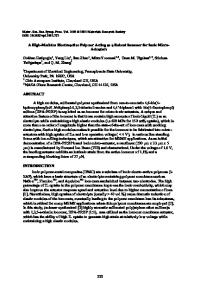High Conductivity Ionic Liquid- Nafion Mat Composites for High Speed Ionic Polymer Transducers
- PDF / 444,848 Bytes
- 6 Pages / 612 x 792 pts (letter) Page_size
- 0 Downloads / 343 Views
0889-W07-06.1
High Conductivity Ionic Liquid- Nafion Mat Composites for High Speed Ionic Polymer Transducers. Barbar Akle1, Donald J. Leo1, Changwoon Nah, and Abdul M. Kader Department of Polymer Science & Engineering, Chonbuk National University Jeonju 561-256, South Korea 1 Center for Intelligent Material Systems and Structures (CIMSS) Department of Mechanical Engineering Virginia Tech, Blacksburg VA, 24061 ABSTRACT Ionomeric polymer transducers consist of an ion-exchange membrane plated with conductive metal layers on the outer surfaces. Such materials are known to generate large bending strain (> 9% is possible) at low applied voltages (typically less than 5 V). The main disadvantage of ionomer–ionic liquid transducers is the slow speed of response. The speed of response in such actuators has been correlated to the ionic liquid content and the conductivity of the membrane. To increase the conductivity of the transducers a NafionTM mat is hydrated with 1-ethyl-3-methylimidazolium trifluoromethanesulfonate (EMI-Tf) ionic liquids and high surface area RuO2 electrodes are attached using the Direct Assembly Process (DAP). The NafionTM mat is prepared from homogenous solution electrospinning. The solution is prepared by mixing 1 wt % of polyethylene oxide solution in methanol (PEO, Mol. wt 3x106) to 5 wt % Nafion 1100 solution.. The syringe needle is connected to a 15kV power supply and is placed 15cm away from the collecting drum. The measured conductivities of water hydrated Nafion electro-spun fibers are 16.8 mS/cm, which are lower than the nominal 110 mS/cm that of H+ Nafion membranes. The uptake is measured to be around 250 %wt compared to 58 %wt obtained in Nafion films. The ionic conductivity of 110 %wt swollen ionic liquids-Nafion mat composite is computed to be 0.9 mS/cm compared to 0.3 mS/cm in ionic liquid-Nafion membrane composite. The speed of response in actuators with an ionic liquid- NafionTM mat is 1.34 %/s compared to 0.88 %/s for that in ionic liquid NafionTM film transducers. INTRODUCTION Ionic polymers membranes are materials that exhibit ionic conductivity and ion selectivity. Several researchers have shown that these polymer membranes can function as electromechanical actuators and sensors [1-7]. An ionic polymer transducer is made of an ionomeric membrane (typically NafionTM, a product of DuPont) sandwiched between two conductive electrodes. In this state the membrane will bend toward the anode when a voltage (< 4V) is applied across its thickness. Similarly, the polymer will generate charge when deformed. Ionic polymer transducers have the advantage of being able to generate large strains (on the order of 10%) under small applied voltages [3], are compliant and thus compatible with conformal structures, and have a very high sensitivity to motion when used in charge sensing mode. Conventional water-diluted ionomeric transducers suffer from the problem of
0889-W07-06.2
dehydration when operated in air and they suffer from low generated force. Bennett and Leo [4] have previously demonstrated
Data Loading...











